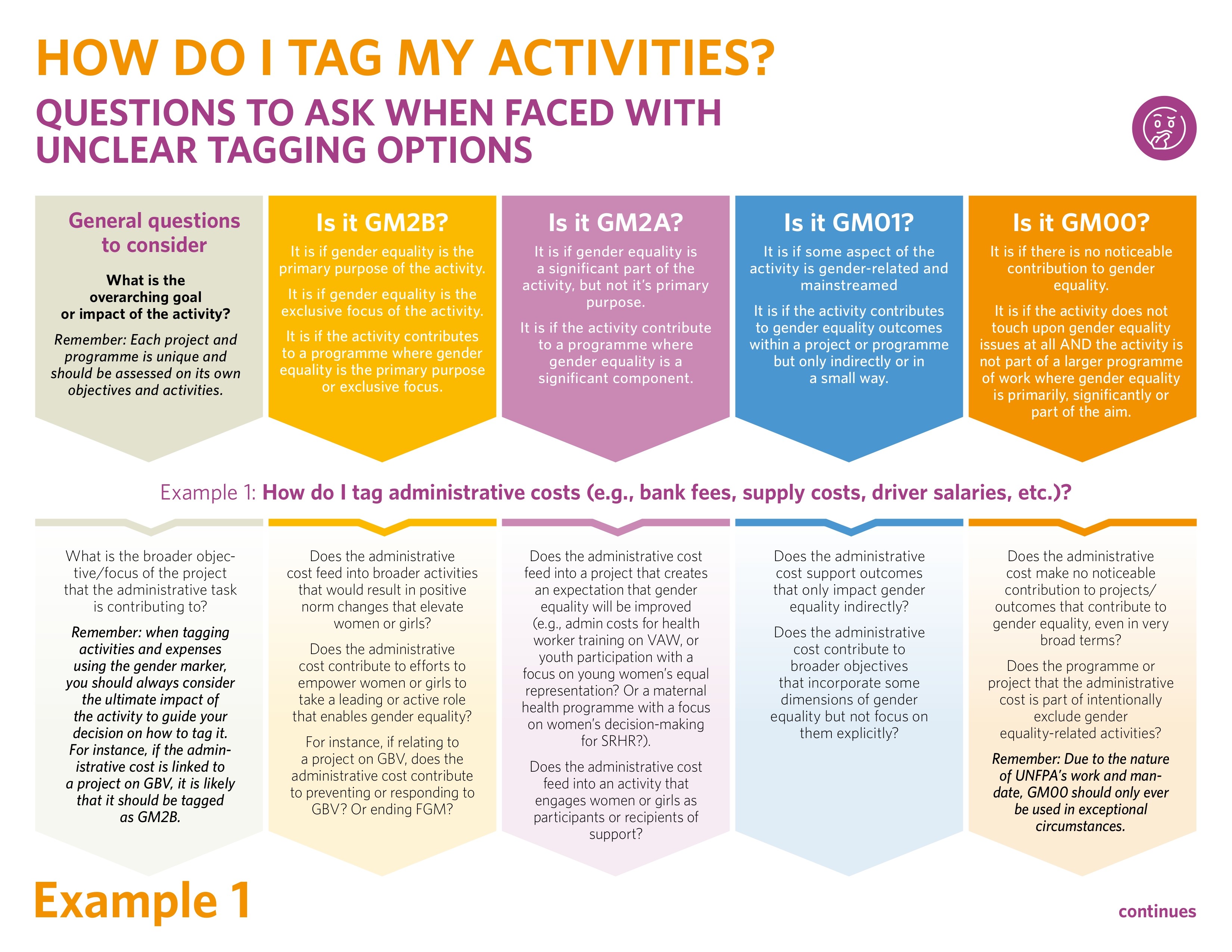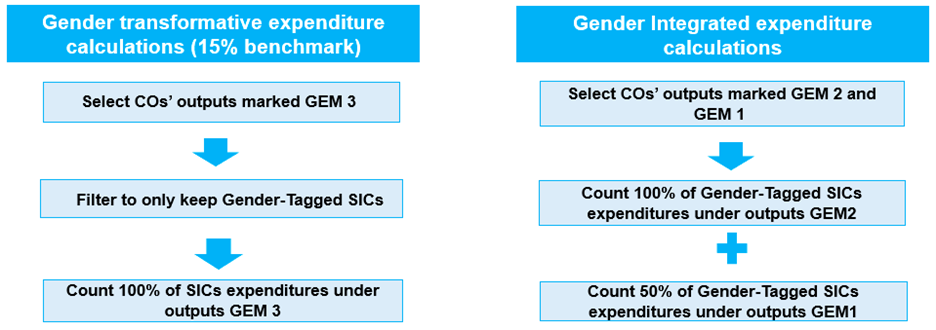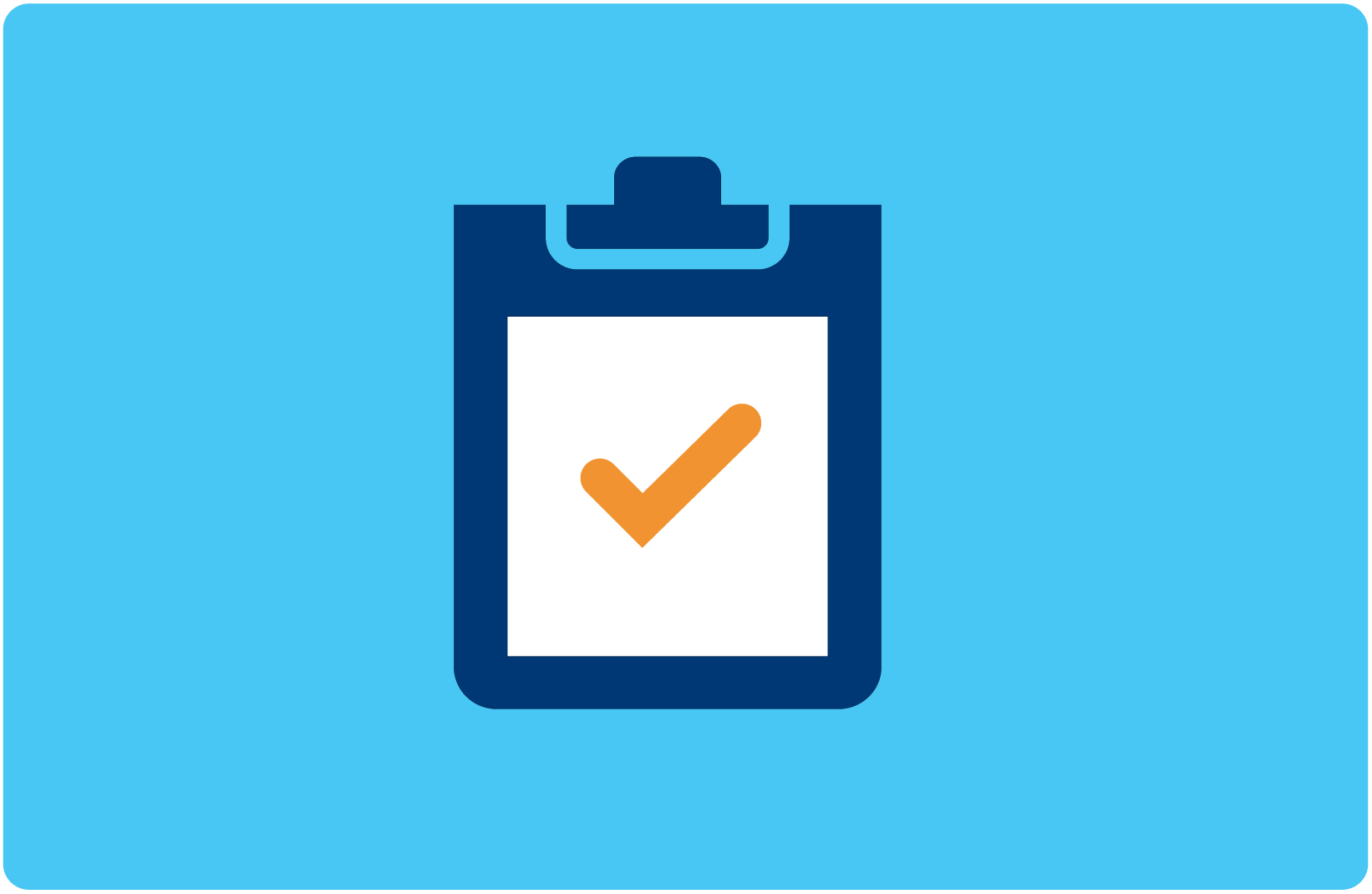Learn from peer entities.
Module 8 contains good practices that have been classified into five main categories: applying the GEM, quality assurance of the GEM, financial targets, coding and tracking GEEW expenditures, and reporting.
8.1 Applying the Gender Equality Marker
UNFPA: Tagging at activity level
UNFPA applies the gender equality marker at the workplan activity level. Tagging at such a granular level reduces the level of subjectivity and ambiguity about the activity’s contribution to gender equality and the empowerment of women and results in greater accuracy and consistency in the application of the gender equality marker and the assignment of a code.

Source: At-a-glance Guidance for UNFPA Staff
UNICEF: Two-tier coding
Since 2018, UNICEF has been applying a two-tier gender coding system at the level of outputs as well as at the level of associated activities at the beginning of a planning cycle or when funds are first received. Using a gender equality marker, outputs (or intermediate results) are coded on whether they will make a principal, significant, marginal or no contribution to gender equality and the empowerment of women. These codes remain fixed throughout the planning cycle.
At the same time, activities under an output are each assigned a pre-filled gender tag value; this includes activities of an administrative or operational nature. The gender tag is based on a two-point scale: 0 (not a gender activity) and 1 (gender activity). Activities correspond to a set of 400, fixed specific intervention codes (SICs) that UNICEF has standardized across the organization. There are approximately 400 Specific Intervention Codes (SIC) of which 120 SICs are inherently gender-related (i.e., gender mainstreamed or gender-targeted).
To link the gender tags with the gender equality marker, the gender marker code is determined, in part, on the percentage of budget allocations made to gender activities under each output:
- GEM 0: 0-25% allocations for gender activities
- GEM 1: 25-40% allocations for gender activities
- GEM 2: 40-60% allocations for gender activities
- GEM 3: 60-100% allocations for gender activities
The two-tier coding system has allowed UNICEF to better align the intention of gender equality programming, which is reflected at the output level, with the use of funds under the same outputs allocated at the activity levels.
8.2 Quality Assurance
UNIDO: Centralized Quality Assurance Process
At UNIDO, gender focal points conduct the initial screening and appraisal of projects using the UNIDO Gender Compliance and Marker Form, which provides a qualitative set of minimum criteria to aid in the correct determination of a gender marker score. Following this review, gender focal points make a recommendation to the Office for Gender Equality and Empowerment of Women for clearance. The Office’s clearance is a prerequisite for obtaining internal, organizational approval of the project or programme and forms part of the mandatory compliance and quality assurance process. The centralized mandatory gender equality marker review system has enabled UNIDO to enhance the quality of gender mainstreaming at the project approval stage. UNIDO has also taken concrete steps to further promote gender-responsive evaluations to ensure that terminal project evaluations of approved projects (after 2015) consistently assess whether the project’s gender marker at entry is reflected in project implementation as well as in the project’s results framework.
Peacebuilding Fund: Multi-tier review process
The quality assurance processes of the Peacebuilding Fund are considered as one of the most rigorous in the UN System. Proposal submissions to the Peacebuilding Fund, including the gender equality marker score, pass through many layers of review before being approved. At country level, the PBF Secretariat staff or main PBF in-country focal points within the UN Resident Coordinator’s Office review the gender marker of all project proposals and, where needed, recommend changes to strengthen the integration of gender equality considerations in peacebuilding initiatives before submitting the projects to the Joint Steering Committee and the Peacebuilding Support Office.
8.3 Financial Targets
Peace Building Fund (PBF)
PBSO was the first entity in the UN system to set a financial target on gender equality and the empowerment of women in response to the underfinancing of the women, peace and security agenda. In 2010, the Secretary-General committed the UN to allocate a minimum of 15 per cent of all peacebuilding and recovery funds to gender equality. After tracking their gender marker data for a number of years, PBSO became concerned at the low level of projects that targeted gender equality as a specific objective. To accelerate progress toward this target, the Peacebuilding Fund launched the Gender Promotion Initiative to incentivize more gender equality targeted proposals. In 2015, the Peacebuilding Fund met the 15% target and exceeded in successive years. The Peacebuilding Fund increased the target to 30% in 2017 and has met or exceeded this target every year since: 36 per cent in 2017, 40 per cent in 2018, 2019, 2020 and a record high of 47 per cent in 2121. These allocations cover the entire portfolio and include projects with gender equality marker scores of 1 (limited), 2 (mainstreamed) and 3 (principal objective).
UNFPA
UNFPA has set a target of 11 per cent for its stand-alone outcome on gender equality (SP Outcome 3: Gender equality, the empowerment of all women and girls, and reproductive rights are advanced in development and humanitarian settings), un applies der the former Strategic Plan (2018-2021). It is important to note that this benchmark is only related to the focused area of work on gender and does not estimate the allocation for gender mainstreamed activities across UNFPA’s other Outcome areas. Indications from the Gender Marker data reveal that actual expenditures for gender equality and empowerment of women and girls have exceeded the benchmark, accounting for over 20 per cent of UNFPA's overall financial budget and spending. In the period 2014 to 2020, the total amount of expenditures assessed using the Gender Marker exceeded USD 11 billion and averaged around USD 1.7 billion per year. This should lead to an upwards readjustment of their target, as UNFPA incorporates more data into this process.
UNICEF
The UNICEF Gender Action Plan (2022 -2025) – with its focus on transformative approaches - commits to going beyond the financial benchmark of 15% of programme expenditures on advancing gender equality as a principal objective. Gender equality marker data already shows that UNICEF exceeded this threshold in 2020 and 2021. Expenditure on gender-transformative results in 2021 was 21.1 per cent, slightly above the 20.8 per cent reported in 2020, and significantly more than the 14.1 per cent in 2018. Moreover, an estimated 64.4 per cent of total expenditure (or approximately 3.9 billion) contributes to gender mainstreaming, as measured by outputs where gender equality is either a significant or a marginal objective.
This target is not only set at the entity-wide level; each business unit at UNICEF is expected to meet this target as well. UNICEF has also added another benchmark on gender equality expenditures for programming in exclusively emergency contexts.
UN COVID-19 Response and Recovery Multi-Partner Trust Fund
The fund has set a 30% financial target for programs that identify gender equality/women’s empowerment as the principal objective (GEM 3) to ensure that funded initiatives addressed the gendered dimensions and implications of COVID-19. The Fund exceeded this financial target in the second Call for Proposals, reaching a 69% of the funds allocated to proposals with a Gender Equality Marker 3 score.
8.4 Coding and Tracking Expenditures to GEWE
UNICEF: An innovative approach to tagging and tracking allocations and expenditures to gender equality and the empowerment of women
UNICEF applies the gender equality marker at all levels of the organization: all of UNICEF’s programme expenditures that are supported by both regular resources and ‘other resources’ are coded against the GEM, including development and humanitarian programmes.
UNICEF has been applying a two-tier gender coding system at the level of outputs as well as at the level of associated activities at the beginning of a planning cycle or when funds are first received. Outputs are coded on whether they will make a principal, significant, marginal or no contribution to gender equality and the empowerment of women. Activities under each output are assigned a pre-filled gender tag value; this includes activities of an administrative or operational nature. The gender tag is based on a two-point scale: 0 (not a gender activity) and 1 (gender activity). Activities correspond to a set of 400, fixed specific intervention codes (SICs) that UNICEF has standardized across the organization.
UNICEF uses its gender equality marker system and its gender tagging system as the two main parameters for calculating gender equality expenditures. UNICEF calculates gender equality expenditures on results that are gender-transformative (GEM 3) and gender-responsive:
- Gender-transformative expenditures are calculated by only focusing on those SICs that are gender tagged under GEM3 outputs; and
- Gender integrated expenditures are based on a weighting of gender tagged SICs under outputs marked GEM 2 (gender-responsive) and GEM 1 (gender-sensitive)

For more information, please check the Good Practice of UNICEF.
8.5 Reporting
DPPA
DPPA reports gender equality marker data as part of internal and external accountability to meeting its women, peace and security commitments related to post-conflict planning and financing. This includes annual reporting on the DPPA Results Framework and the UN System-wide Action Plan on Gender Equality and the Empowerment of Women (UN-SWAP). DPPA also shares this data annually with the Security Council as part of the progress of special political missions and headquarters made on WPS commitments as well as in the annual Report of the Secretary-General on Women, Peace and Security. Gender equality marker data is also reported to donors as part of the Multi-Year Appeal Annual Report. The Annual Report includes both financial and substantive reporting on the use of MYA contributions and its main results.
UNFPA
UNFPA reports on an annual basis to its Executive Board on the high-level results related to gender equality and empowerment of women and girls, as part of entity reporting on the implementation of the Strategic Plan and on the Gender Equality Strategy. as well as on the gender marker.
Expenditures related to regular and other resources are reported on each GEM code and include global, regional and country as well as other programme activities. In addition, UNFPA reports on the gender marker by the type of assistance (i.e., development, humanitarian) as well as by region.
UNIDO: Tracking and making public allocations to gender equality and the empowerment of women
UNIDO makes its gender marker data publicly available in real-time on UNIDO’s Open Data Platform. The Platform displays financial information on all ongoing programmes and projects and shares the financial allocations of UNIDO’s programme/project portfolio to gender equality and the empowerment of women by gender marker codes.
Additional Resources
Check the experience from entities in implementing the GEM: UNIDO, UNFPA, UN DPPA, UNICEF, UNDP, Peacebuilding Fund, ESCWA.
